
Coaxial cable, or coax, is a type of electrical cable consisting of an inner conductor surrounded by a concentric conducting shield, with the two separated by a dielectric ; many coaxial cables also have a protective outer sheath or jacket. The term coaxial refers to the inner conductor and the outer shield sharing a geometric axis.
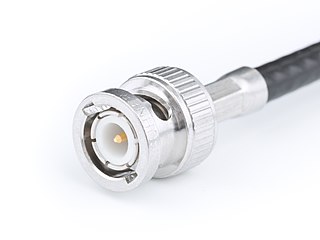
The BNC connector is a miniature quick connect/disconnect radio frequency connector used for coaxial cable. It is designed to maintain the same characteristic impedance of the cable, with 50 ohm and 75 ohm types being made. It is usually applied for video and radio frequency connections up to about 2 GHz and up to 500 volts. The connector has a twist to lock design with two lugs in the female portion of the connector engaging a slot in the shell of the male portion. The type was introduced on military radio equipment in the 1940s and has since become widely applied in radio systems, and is a common type of video connector. Similar radio-frequency connectors differ in dimensions and attachment features, and may allow for higher voltages, higher frequencies, or three-wire connections.

The APC-7 connector is a precision coaxial connector used on laboratory microwave test equipment for frequencies up to 18 GHz. APC-7 connectors are advantageous because they have a low reflection coefficient, make repeatable coaxial connections, and are genderless. The connectors are expensive, so they are seldom used outside the laboratory where their cost can be justified by their accuracy and convenience. Due to their high cost, their 18 GHz frequency limitation, and new laboratory practices, the connectors are now uncommon. Modern low-frequency microwave equipment often uses the less expensive 3.5 mm (26.5 GHz) connector. Higher-frequency equipment must use higher-performance connectors such as the 2.92 mm (40 GHz), 2.4 mm (50 GHz), 1.85 mm (67 GHz), or 1.0 mm (110 GHz) connectors.
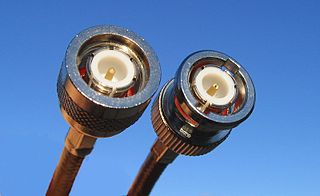
The TNC connector is a threaded version of the BNC connector.

The F connector is a coaxial RF connector commonly used for "over the air" terrestrial television, cable television and universally for satellite television and cable modems, usually with RG-6/U cable or with RG-59/U cable.

The C connector is a type of RF connector used for terminating coaxial cable. The interface specifications for the C and many other connectors are referenced in MIL-STD-348. The connector uses two-stud bayonet-type locks. The C connector was invented by Amphenol engineer Carl Concelman. It is weatherproof without being overly bulky. The mating arrangement is similar to that of the BNC connector. It can be used up to 11 GHz, and is rated for up to 1500 volts.

SMA connectors are semi-precision coaxial RF connectors developed in the 1960s as a minimal connector interface for coaxial cable with a screw-type coupling mechanism. The connector has a 50 Ω impedance. SMA was originally designed for use from DC (0 Hz) to 12 GHz, however this has been extended over time and variants are available to 18 GHz and 26.5 GHz. There are also mechanically compatible connectors such as the K-connector which operate up to 40 GHz. The SMA connector is most commonly used in microwave systems, hand-held radio and mobile telephone antennas and, more recently, with WiFi antenna systems and USB software-defined radio dongles. It is also commonly used in radio astronomy, particularly at higher frequencies (5 GHz+).
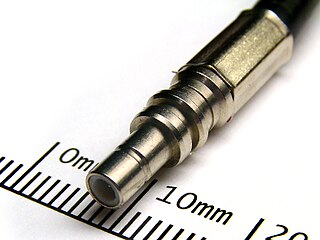
SMB connectors are coaxial RF connectors developed in the 1960s. SMB connectors are smaller than SMA connectors.

SMC connectors are coaxial RF connectors developed in the 1960s. The interface specifications for the SMC and many other connectors are referenced in MIL-STD-348. They use a #10-32 UNF threaded interface. They offer electrical performance from direct current (DC) to 4 GHz. Some extended performance versions are rated to 10 GHz. The normally free part of a SMC connector that has a socket for the centre contact are the female connectors. The normally fixed part SMC connectors that has a pin for the centre contact are the male connectors. This is the reverse of most RF connectors. SMC jack connectors have an external thread while SMC plug connectors have the mating hex nut. The contact dimensions are identical to the snap-fit SMB. Available in 50 ohm and 75 ohm characteristic impedance, they provide an interconnect means for small form factor coaxial cables and printed circuit boards where small footprint is important.
Amphenol Corporation is an American producer of electronic and fiber optic connectors, cable and interconnect systems such as coaxial cables. Amphenol is a portmanteau from the corporation's original name, American Phenolic Corp.
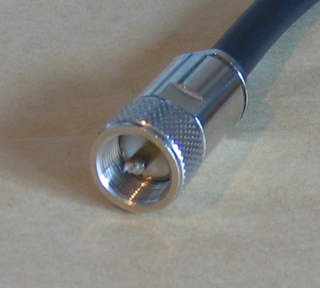
The UHF connector is a name for a threaded RF connector. The connector design was invented in the 1930s for use in the radio industry, and is a shielded form of the "banana plug". It is a widely used standard connector for HF transmission lines on full-sized radio equipment, with BNC connectors predominating for smaller, hand-held equipment.

The term Amphenol connector refers to various electronics connectors that are introduced, or made primarily by Amphenol Corp. Depending on the area of electronics concerned, it may refer specifically to:
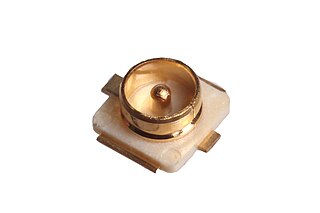
Hirose U.FL, I-PEX MHF I, AMC or UMCC is a miniature RF connector for high-frequency signals up to 6 GHz manufactured by Hirose Electric Group, I-PEX, and others.
EIA RF Connectors are used to connect two items of high power radio frequency rigid or semi-rigid (flexline) coaxial transmission line. Typically these are only required in very high power transmitting installations where the feedline diameters may be several inches. The connectors are always female, requiring a male coupling element or bullet to make the connection. The EIA under the Electronic Components Industry Association, are responsible for a number of standard imperial connector sizes.
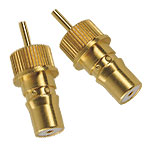
QMA and QN connectors are quick-connect RF connectors that were designed to replace the widely used SMA and Type N connectors. The connectors have been available since 2003. The connector family was created by the Quick Lock Formula Alliance, which consists of Huber+Suhner, Radiall, Rosenberger Hochfrequenztechnik, and Amphenol.

Electrical or fiber-optic connectors used by U.S. Department of Defense were originally developed in the 1930s for severe aeronautical and tactical service applications, and the Type "AN" (Army-Navy) series set the standard for modern military circular connectors. These connectors, and their evolutionary derivatives, are often called Military Standard, "MIL-STD", or (informally) "MIL-SPEC" or sometimes "MS" connectors. They are now used in aerospace, industrial, marine, and even automotive commercial applications.

A concentric twinax connector has a center pin and a cylindrical intermediate contact as compared to a dual polarized pin type.

The DIN 1.0/2.3 connector is a RF connector used for coaxial cable at microwave frequencies. They were introduced in the 1990s for telecommunication applications. They are available in 50 Ω and 75 Ω impedance and are compatible with the most widely used cable sizes. It has a push/pull lock and release feature. The DIN 1.0/2.3 is ideally suited to applications where space limitation is a factor. In broadcasting applications the 75 Ω version is used for Serial Digital Interface video data up to maximum frequency of 4 GHz. The 50 Ω connector can be used to a maximum of 10 GHz.

The 4.3-10 connector is a 50 Ω multi-purpose RF connector used to connect coaxial cables with other cables or RF devices, such as transmitters or antennas.




















